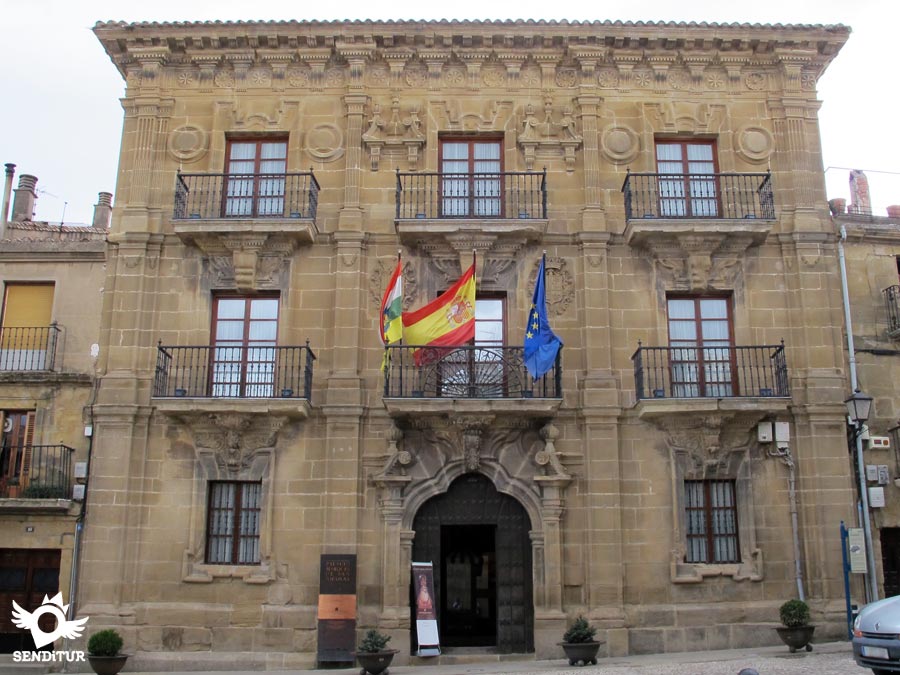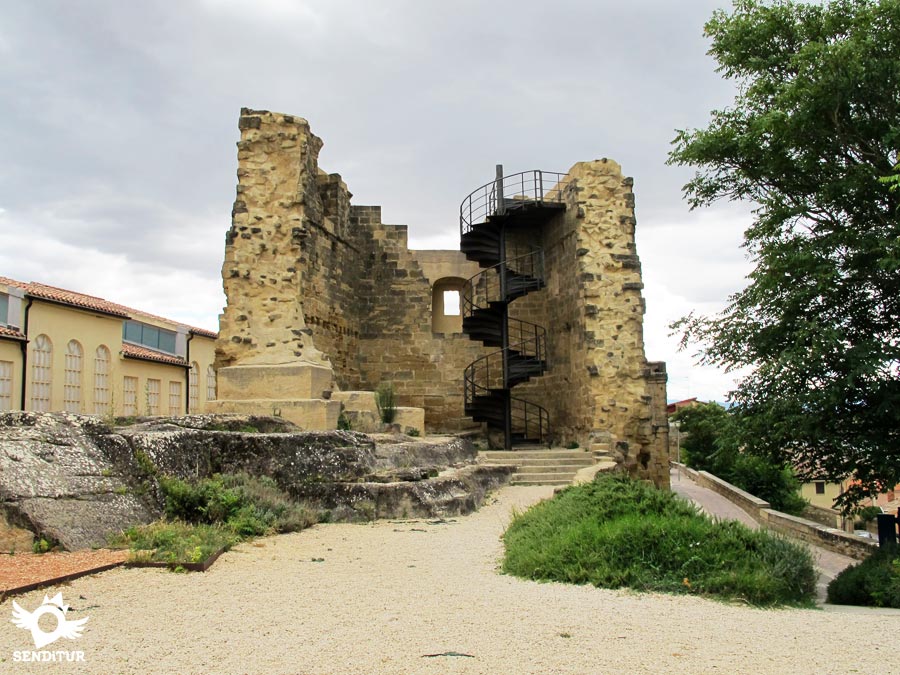It is to the northwest of the Autonomous Community of La Rioja, nestled on a hill that makes it an incomparable viewpoint over the river Ebro that seems to run surrender at its feet, and in the distance, Sierra Cantabria with Peñacerrada and the Toloño, and the Sierra de la Demanda surrounding and protecting the vast and spectacular landscape that surrounds the town. Although the name Briones comes from the ancient settlers of La Rioja, the Berones, who were known as Britones, it seems that the locality had older settlements, according to the remains found in the Bronze Age archaeological site which is close to the hermitage of the Santos Mártires. Little is known about Roman times, but there are signs of a roadway. It was under Muslim rule until Alfonso I expelled them around 740. However, it was not until the tenth century that Briones passed into the hands of the Christian kings Ordoño II de León and Sancho Garcés de Navarra, constituting the border between the two kingdoms when, with the assassination of Sancho el de Peñalén in 1076, Alfonso VI of Castilla y León seized La Rioja.

The first reference to the Lordship of Briones is 1236 when Fernando III the Saint grants it to Diego López de Haro; this one, years later was revealed against the king and was fortified in the castle of Briones, but Fernando III managed, after a siege to the fortress, to make him a prisoner and since then the town became a royal villa. Alfonso X granted it privileges with the intention of repopulating the area with Castilians in order to meet Navarre's aspirations, but this did not mean that the town ceased to be the scene of struggles for its possession and passed from one hand to another. The last lord of Briones was Mariano Téllez- Girón y Beaufort and it was until 1837 when the Court of Justice confirmed the sentence given in 1818 on the incorporation of Briones into the Crown. Until the 18th century, Ollauri, Rodezno and Gimileo were villages in Briones. The War of Independence and the Carlist Wars also affected Briones, which suffered, in its people and in its environment, the war excesses. Today Briones is a modern town where its roots and history are always present.

A quiet stroll through this town, declared a Historic-Artistic Site, takes the admired visitor from one corner to another, from one building to another. Of the little that remains of its walls you can see the Puerta de la Villa and the Puerta de la Concepción, but within what these walls kept there is a mansion that is considered the oldest in La Rioja, located in a corner of the beautiful Plaza de España where it also houses the palace de los Marqueses de San Nicolás, which was completed in 1755, today is the headquarters of the City Council and also houses the Ethnographic Museum known as La Casa Encantada. The Church of Nuestra Señora de la Asunción, is built in ashlar stone, is mainly Renaissance style of the sixteenth century. The palace de los Quincoces, a building built in the middle of the 16th century, in which the northern Renaissance can be appreciated. The House of the Gadea family, the House of the Díaz-Lizana family, the solar house of the Moscoso del Prado family; hermitages such as that of San Juan or Santo Cristo from the 18th century, that of the Santos Mártires, that of Santa Lucía, that of San Andrés or that of San Bartolomé, that of El Calvario or that of La Concepción; the old Abbey, which is a building that is on the corner with the Calle Mayor and dates from the second half of the 18th century, which together with the church tower form a beautiful image of the town, are remnants of a history and a culture full of splendour.

In the Paseo de las Cercas del Torreón, the ancestral home of the Sáenz de Cenzano family, known by the name of El Torreón because of the building at one end, from which the view is flooded with an impressive and spectacular panoramic view showing the Sonsierra, the Rioja Alavesa and the Toloño and Peñacerrada mountain ranges. Vigilante, as in other times, in the highest part of Briones the remains of the tower of homage of the castle of Briones give their for good to the visitor who cannot leave the town without a tour of the old caves and cellars, much less stop visiting the Wine Museum, which will be a nice colophon to such a pleasant tour.
On the Sunday following 14 September, the patron saint fiestas are celebrated in Briones, commemorating the Santo Cristo de los Remedios (Saint Christ of the Remedies), patron saint of Briones. On the Sunday following the 3rd of May, Cruz de mayo, the image of Santo Cristo is carried in procession from the hermitage to the parish church, and in September, on the occasion of the fiestas, the image is returned to the hermitage. Briones also celebrates San Isidro on 15 May; on the Saturday before Easter there is a pilgrimage to the hermitage of La Concepción and on the last Sunday in August the pilgrimage is in honour of San Emeterio and San Celedonio.

In the Paseo de las Cercas there is a layout of the promenade that is called Cercas de las Cuarenta because, according to tradition, 40 churches could be seen from here and the person who approached and prayed with their eyes set on them gained 40 days of indulgences.
The town celebrates the third weekend of June the Medieval Days of Briones, festivals declared of National Tourist Interest. For a few days the locality moves back in time to the 14th century. The medieval atmosphere floods everything: houses, streets, people and their way of life, blacksmiths, musicians, knights, templars, buffoons... fights and tournaments, trials and even a burial is represented, that of Count Martín de Lafita.

The legend goes around Briones that the spirits of the López de Haro roam around the remains of the castle, giving it life with their presence and trying to keep it standing.
MORE ROUTES AVAILABLE, DON'T MISS IT...
MORE PLACES AVAILABLE, DON'T MISS IT...
Briones is in the middle of the N-232 between Logroño and Haro. You can also get there by following the AP-68 motorway to Haro and from there head towards Briones. The locality is also reached by different regional roads such as the LR-314 that joins Briones with Hormilla on the A-12 between Logroño and Burgos, while the LR-210 joins Briones with San Vicente de la Sonsierra and the N-232a that crosses the other slope of the Ebro valley, passing through Labastida, Ábalos or Laguardia, among other localities.
Briones has a daily bus service at different times that covers the Logroño-Haro-Miranda de Ebro line and from Monday to Friday there is another service that covers the Haro-Nájera line. The bus stop is at the marquee destined for it.
The Briones train station is located on the road from Briones to Peñacerrada.
The closest airport to Briones is Logroño-Agoncillo.
SENDITUR is not responsible for any variation in the information described, as well as for the misuse of its guides and recommends that everyone be responsible and prudent in carrying out the activity. Likewise, we invite you to document yourself with books and specialized guides to complement the information described. From the commitment of SENDITUR with Nature and the respect to the balance of the environment, SENDITUR urges you to travel in a responsible way, with low environmental impact and respecting at all times the Natural, Cultural and Social environment wherever you go. For any suggestion, SENDITUR invites you to send an email to .
Continue watching …